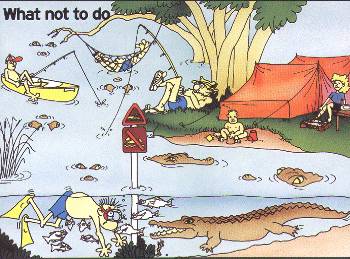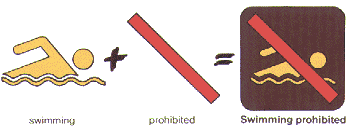| |
|
|
 An Education Kit
for Grades 5 - 7 An Education Kit
for Grades 5 - 7
|
Information
Sheet
living safely with crocs
|
|
Attack Facts
| 1980 - 90 |
number of deaths
(Australia-wide) |
| croc attack deaths |
8 |
| shark attacks |
9 |
| bee stings |
20 |
| drownings |
3,367 |
| traffic accidents |
32,772 |
| 1991 - 98 |
|
| croc attack deaths |
2 |
|

Click for larger version |
|
Do's and Don'ts
- Obey crocodile warning signs. Just because you don't see any crocs doesn't mean they aren't there.
- Don't go swimming, paddling or wading in areas where there are likely to be crocs. This includes coastal areas and beaches in some places.
- Keep well away from the waters edge in croc country. Avoid washing dishes and gutting fish on river/billabong banks and be very cautious when collecting water.
- Be cautious when fishing and don't stand in the water.
- Don't share food scraps or fish guts with crocs; they may come back for more!
- Don't sit on branches overhanging a croc creek. Crocs can and do jump
- Don't camp within 50m of water
|


|
- Don't assume because someone else was safe that you will be also; crocodiles are aware of areas regularly used by animals seeking water. Remember you are an animal too!
- Be careful in boats. Crocs can overturn canoes and a foot dangling over the edge may prove irresistible.
- Don't be complacent. Large crocs rarely show themselves and approach very stealthily.
- Adults should supervise children when near water in croc country.
(Source: Tropical Topics 29 July 1995. Department of Environment and Heritage) |
|
video clip
- safety messages about no swimming, boating in croc habitats (14 secs, 109 K) view
|
|
| |
|
|
|
|
|
|
|